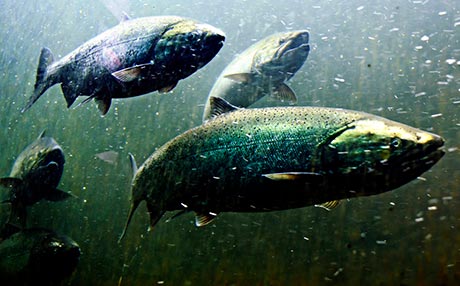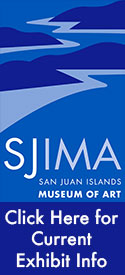The Kings of the Yukon River
Posted July 19, 2020 at 5:33 am by Tim Dustrude

Photo by Richard Lawrence
FREEZER BURNED: Tales of Interior Alaska is a regular column on the San Juan Update written by Steve Ulvi…
The days of subarctic summer blend together and can unsettle internal rhythms. This is both a blessing and a curse, in having so many outdoor activities and a greatly expanded opportunity to overdo it. The reality of it all is hard to convey to those who haven’t lived it.
Summer in the higher latitudes is a time of sweet deception. In the seasonal subsistence cycles of the upper Yukon River region there are many upticks in activity. The annual July harvest of king salmon, perhaps our most indispensable food resource for over 20 years, flames brightly in my memories.
Interior Alaska summers are brief, but charged with a surreal energy. On the heels of summer solstice, days begin again in the wee hours after a short interlude of nightfall. The midnight sun radiates an excess of light and heat (you have seen the monstrous cabbages), and for a couple months anyway, lulls a person to disremember the dramatic long winter night that will arrive soon enough.
In the coniferous forest, the shady ease of early morning is laced by the ethereal calls of thrushes and distant guttural raven talk. Our home cabin, was set back from the tempestuous river, and hunkered under a protective canopy of tall white spruce. With water ladled from the corner barrel, reassuringly heating on a two-burner stove for strong coffee, I had a moment to scrape some enamel dinner plates to toss out some fish skin and scraps for our clownish ‘camp robber’ jay family. Twittering, bustling, always foraging, but quiet and approachable, unlike all other jays. A hearty cut of lightly brined salmon belly sizzled in bear grease and sopped up with a sourdough muffin was a perfect start for the day at hand.
By habit I noted the high barometric pressure and jotted the temperature on the wall calendar, while our banged-up thermos filled. Quietly I gathered up my musty second layer of clothes hoping to slip out without waking the family. Bub, the cabin watch dog, let out a couple throaty whimpers with full-on hip gyrations as I stepped out onto the porch, but didn’t bark. Well trained. Breathing in deeply, the morning sparkled with the deep satisfaction of harvest and putting food by.
It was a short walk down the winding trail cut through deep moss to our raised garden beds and laddered fish cache on the elevated river bank. With my ever-present rifle and buckets in our wheelbarrow, the grassy low roof of our shop cabin was just visible beyond the garden area. A perched sentinel raven alerted her group on the beach of my arrival. After ear-scruffing the chained dogs that greeted me, I filled a couple over-turned water containers and set them at the radius of chain reach. Excavated depressions in the sandy soil indicated boredom and seeking some mid-day heat relief. Shed winter fur still clung in the weeds. Our leafy garden needed watering, and the smokehouse fire would need rekindling soon, before flies emerged at 53F. But those tasks would have to wait.
The path dropped down through the willow belt onto the sloping beach of silt and embedded rocks. The view opened to a sweeping river bend we called Windy Corner. A dead calm coolness blanketed the river while the lingering odor of fish met me at the cutting table. Our stained and duct-taped raingear aired out, held down by rocks. Even with a spring bear in the larder, habit made me pause long enough to scan the river and the two miles of opposite shoreline for wildlife, river trippers or useful highwater flotsam before stepping toward our tethered boat. Brightly colored tents and a log raft with long sweeps at rest stood out in the low, burnished light a mile up at Boundary Creek.
After loading galvanized tubs and gear I pushed off, bulbed the fuel line and yanked the multi-colored 18 horse to life. The river was rising after days of heat pushing 90F and intense afternoon thunderstorms that were so predictable that we referred to them as the “2 O’clock Express”. Woody drift had noticeably increased, even along the smooth flow of our inside bend. I realized that I would have to move our table farther up, once again. My elated anticipation of a good net check fizzled a bit, knowing there would be plenty of drift in the net to deal with.
The kings finning by-one of the longest run stocks in the world- were making 25-40 miles a day, invisible in the roiling, silty water of the Yukon River sliding by at 8 or 9 mph. We had anticipated the vanguard of “jacks” and smaller males, listening to faint AM radio reports, town gossip and rumors buzzing up the river for weeks. Our sixty-foot, 8 ¼ inch mesh net in a small eddy caused by Hole in the Rock, was the last Alaskan obstacle for fish following the molecular odors along our north bank. Every one of these magnificent fish were homing to waters of origin well upriver in the Yukon Territory. Thank you very much Canada, eh!
The dendritic basin of the Yukon River is immense (321,500 square miles) and supports several separate salmon runs, but we lived 1,225 miles from the mouth, where only summer king and fall chum surged by our nets. Even the longest run Coho and Summer Chums veered into large tributaries hundreds of miles short of our region. Kings coursing by our net had a long way to go to side stream procreation and an exhausted death.
The crucible of deep time and genetic variation has honed these upriver stocks of salmon to be robust in body and remarkably rich in stored fat. I suppose that the latter Pleistocene glacial cycles left much of the Yukon River basin unbound by ice and ecologically functional, where summer salmon runs could flourish. American Lions, Short-faced Bears, and Wooly Mammoths as well as other fantastical species roamed the arctic steppe expanses while other drainages and ranges were locked in ice. Early Asiatic ‘proto-Indian’ groups advancing across the immense Bering Land Bridge used the same treeless corridor later in our Holocene Epoch. I can only imagine that fish were a welcome change of diet, and low risk, in that cold, dry, billowing loess-clouded environment inhabited by dangerous beasts.
Cohorts of those earliest immigrants settled along the big river some 11,000 years back rather than continue south into the Americas. Athapaskan Indian groups eventually expanded across North America, but the Han Hwech’in subgroup stayed in the region that we so recently came to call home. They successfully adapted to thousands of years of post-glacial warming and the incursion of taiga forests and new fauna. To my mind, the Han were unfortunate to live along the great river exactly where the US-Canada border would be drawn, and later where the 1898 Klondike Gold Rush exploded in a summer. An overwhelming and indifferent cultural swamping ensued in a few short years.
As one would expect, the Han were expert in their slender, pointy birch bark canoes that allowed for poling (think modern hiking poles, but longer, one in each hand) upstream along shallows and back sloughs as well as paddling. Lacking spawning streams in which to trap kings with weirs, the western Han groups had devised an elegant, almost mystical method of harvesting this rich food source. Elders advised sharp-eyed look-outs on high banks who scanned the surface of the near shore water for hours on end, seeking the subtle wakes and surface clues of swimming kings. The lookouts then directed waiting canoe men by voice directions to intercept them with woven dip nets or spears. A riot of cross-sliced filets and split heads smoked on pole racks.
After cruising on languid water for a few hundred yards, I slowed the outboard to swing into the foot of the back eddy in order to ease up to the dancing anchor float. Cutting the motor, I instantly heard the kaaaak-kaaak-kaaking of the breeding peregrines streaking, chased by a mimicking shadow, along the steep rock face across the river. Several net floats were submerged while a stretch of three were vigorously tugging down and splashing near the deep end. Big fish alive yet! But a daunting stew of sticks and debris many feet across, hugged the bellied arc of floats.
The river was still rising and the net curved nearly to the ‘eddy fence’, I grabbed the jug and worked toward the shore attachment while pushing the float line under a few inches with a flat paddle tip, pausing to allow some debris to flow over the net into the river current and away downstream. Starting at the shore had the advantage of untangling and tossing larger sticks and branches high on shore, until far enough off to be forced to pile them into the boat while pulling fish.
The submerged floats section produced a couple ‘jacks’, some dead 20’s and a fine 30 pounder badly tangled, while the thrashing section held a wild-eyed 50-pound male and female of about 40 pounds very much alive. Bent over, fingers curled in the mesh, wrestling 90 pounds of thrashing salmon up on the gunwale is dicey, but a lot safer than from a canoe as we did in the first years. Quickly whapping the big male into submission in order to more easily try to release the already blushing egg laden female, was a small gesture of respect for the anadromous journey.
Small popcorn clouds built quickly over the arc of Ogilvie Mountains just upriver, as the rising morning heat bubbled up-slope and into an unstable pale blue sky. At the cutting table gutting and slicing revealed the beautiful firm orange flesh of a dozen kings. Trimmed filets from the six largest fish, some nearly three feet long, would be carefully sliced thin to fill out the recently started cold smoker. Heads and guts filled plastic buckets, waiting to be dug into garden beds with the large dog cooker still full. Skeins of bright egg sacs were dried for dog snacks as we had never seen fit to eat salmon egg soup. The meaty filets went into clean buckets to be hefted up the bank and wheelbarrowed up to the cabin.
As I sloshed water and scrubbed the table I noticed a bright yellow kayak surge around the dark knob of Hole in the Rock, heading my way at a steady clip, paddle flashing alternately. I guessed an unexpected visitor from Fairbanks, or maybe an intrepid long-distance tripper plying the Yukon uphill. The hard way. I waited with interest while a couple of graceful Mew gulls bickered and swam in circles just off-shore, gulping fish scraps washed their way. A dozen bright swallow-tail butterflies danced on recent pee spots in the dry sand above the table.
Bumping ashore, ‘Marco’ deftly sprang out of his craft, smiling broadly with perfect teeth, and reached out to shake my hand. After noticing the large dinner plate head of the biggest fish with wide eyes, in halting English he conveyed that he was trying to make the headwaters before the snow. He planned to hike over the famed Chilkoot Trail to meet up with his girlfriend in Skagway to sea kayak south to overwinter on the B.C. coast somewhere. He looked upstream to the 40-foot wide border swath, straight as a zipper up and over the southern ridgeline, asking about the border crossing requirements. Laughing, I explained that we were the only people at the border and it was wide open to travel. As a European he couldn’t quite grasp that.
We looked over his worn topo maps and I penciled in the best shores to hug, fresh water seeps, fish camps and cabins of friends below Dawson City, 93 miles upriver. He welcomed a prime chunk of salmon collar laughing with his whole being. A young man having the time of his life. With dark brown eyes dancing he said Grazie Stephano! Tucking the fish away, then adjusting long bow and stern lines around his waist with determined strides he lined his kayak up to distant cliffs and disappeared into Canada, tiny paddle flashes as he crossed the river.
While our two grubby kids played in the dirt, Lynette further cleaned and expertly cut the sides to stuff carefully cleaned quart jars and lock the lid down on our pressure cooker, steaming six quarts at a time. Vinegar water was the indispensable sanitizer and de-slimer of choice. Then again, and again, she processed fish over several days. We cut long, skin-on strips to soak in salt water, before stringing in pairs to hang for a week or more in the cold smoker. This delectable treat was called ‘squaw candy’. There would be another net check in the evening in the ozone after-glow of a thunderstorm that would soon unleash tarp-flapping winds, pea hail and a downpour to drive us indoors for a couple hours of cozy respite. With any luck in a few days, we would reach our annual goal of 40 to 50 kings and tie the net up, to drop some web for a fresh king once in a while as the run petered out.
We fished under State of Alaska rural subsistence regulations, that became increasingly politicized and complex as a result of the ‘Great Partitioning’ of old Alaska. We felt that kings were people food, not to be wasted or harvested to feed animals, but treated like the extraordinary gift they were. Not everyone felt that way. Gone were the days of large fish-wheels turning with eerie groans in the relentless river current, each harvesting scores of kings every day, more than a thousand miles from the Bering Sea.
Boat loads of research papers and studies dryly describe the slow decline of the Yukon king run so far from the madding crowd, yet under intensifying pressure from salt water by-catch, warming in the North Pacific, fungal diseases, lack of in-river run strength data for management, lower river commercial use dominance, market expansion, increasing harvest of salmon to feed large dog yards for long distance racing and testy international treaty negotiations with Canada. The same old sad story of diminishing salmon (even where extensive habitat remains intact) exacerbated by the limited timeframes of experts all seeking career “success” in short term increases of some sort, while ignoring the substantial decline from original population levels.
(Next: The River Floaters of Summer)
You can support the San Juan Update by doing business with our loyal advertisers, and by making a one-time contribution or a recurring donation.
Categories: Freezer Burned










No comments yet. Be the first!
By submitting a comment you grant the San Juan Update a perpetual license to reproduce your words and name/web site in attribution. Inappropriate, irrelevant and contentious comments may not be published at an admin's discretion. Your email is used for verification purposes only, it will never be shared.